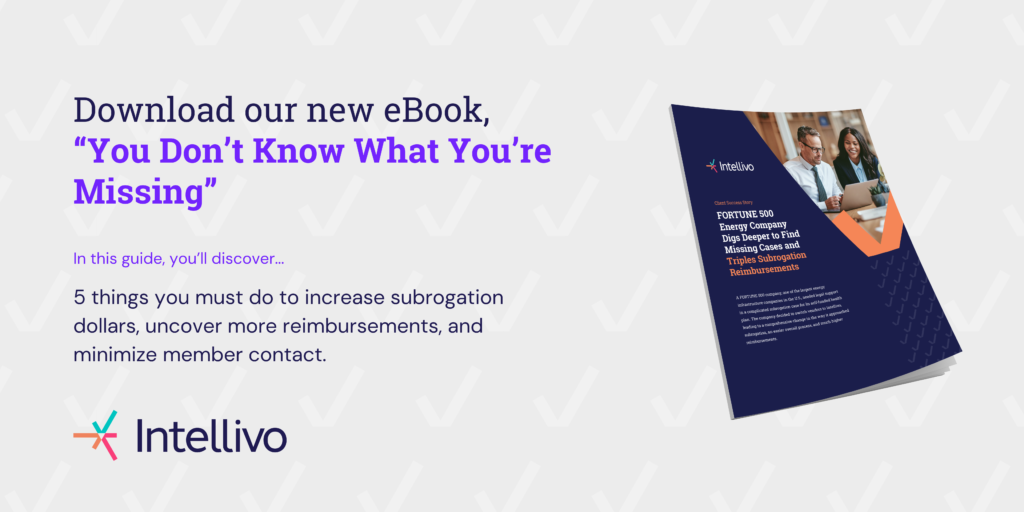The stakes have never been higher for health plan leaders, as rising healthcare costs continue to outpace overall inflation. The latest data about the increasing number of mega claims is especially concerning: claims of $1 million or more surged 29% in 2024, and claims exceeding $3 million jumped 47%, according to Sun Life’s 2025 high-cost claims analysis.
These jumbo claims are just the tip of the iceberg in a landscape of soaring healthcare costs. For self-insured employer health plans, which absorb the financial risk of every claim, the need for strategic cost containment has become mission critical. That means going beyond blanket cost-cutting to focus on sustainable savings, smarter processes, and long-term value creation.
While many plans emphasize pre-pay review practices, too often they overlook what happens after claims are paid. Without a strong post-pay strategy, significant recoverable dollars go unclaimed. That’s where smarter subrogation plays a pivotal role.
It’s important to look at subrogation as part of a broader cost continuum, applying the same rigor that is spent on prepay services to post-pay as well.
– Laura Hescock, CEO, Intellivo
Health plans that incorporate post-pay diligence into their overall cost containment strategies, achieve better financial outcomes.
For example, subrogation plays a vital role in recovering dollars from legal suits tied to high-dollar claims—often the very claims that create the most financial strain. These cases frequently involve complex liability scenarios, catastrophic injuries, and protracted litigation. Without a focused strategy to identify and pursue reimbursement from lawsuits and legal settlements, plans risk leaving substantial recoverable dollars on the table. In today’s landscape of growing mega claims, overlooking these opportunities can have significant financial consequences.
Subrogation as a Strategic Financial Lever
In a recent BenefitsPro webinar, Intellivo CEO Laura Hescock and COO Charm Pratt discussed common cost containment challenges and the best practices claims professionals should adopt to fulfill their fiduciary responsibilities.
Accident-related medical claims represent at least 5% to 6% of total paid claims, if not more, but reimbursement potential from an alternative payer can often be overlooked. For self-funded health plans, in particular, that often translates to millions of dollars in missed recoveries.
That’s why subrogation should be considered a key component of an overall cost-savings strategy, not just a component of claims processing.
“The money is meaningful, in terms of potential reimbursements,” said Pratt. “These are not rounding errors.”
Hescock added, “It’s important to look at subrogation as part of a broader cost continuum, applying the same rigor that is spent on prepay services to post-pay as well, so that you have that full continuum of financial clarity.”
Common Challenges Undermine Recoveries
One of the biggest challenges health plans and benefits administrators face is identifying medical claims for which someone else is liable and capturing the reimbursements to which they’re entitled.
Hescock drives this point home in the webcast, emphasizing the importance of identifying opportunities in the first place. “After that, none of the other pain points or leakage areas are going to be relevant,” she said. “It’s easy to see what is being recovered. It’s more difficult to have visibility into what was not identified to be recovered.”
The problem is that many health plans don’t have a consistent process for identifying subrogation opportunities. To identify subrogatable opportunities within your paid claims, you must determine which claims were directly related to an accident, what caused the accident, who was involved, and most importantly, who should pay.
As detailed in Intellivo’s eBook, “You Don’t Know What You’re Missing,” you can’t recover what you can’t see.
“We’ve seen plan providers miss out on millions of dollars because the process failed to protect it,” Pratt added. “Whether it’s due to delays in detection or issues with lien compilation, these breakdowns or claims leakage have real financial consequences.”
Think about it through this lens: if you’re a CFO, every subrogatable dollar that you’re able to recover is $1 of margin that goes back to your bottom line.
– Charm Pratt, Chief Operating Officer, Intellivo
Differentiating Through a Better Member Experience
Approaching subrogation in the context of strategic cost containment also elevates the importance of member experience. Recoveries from third parties mean that plans don’t have to raise premiums or cut benefits to manage rising costs, something especially valuable for HR and finance leaders.
“In today’s highly competitive landscape, every dollar counts,” Charm said. “Think about it from this lens: if you’re a CFO, every subrogatable dollar that you’re able to recover is $1 of margin that goes back to your bottom line. If you’re an HR benefits leader, there is an opportunity to extend the same benefits or coverage without having to pass that cost to your employees.”
Unlike traditional subrogation methods, which rely on member questionnaires, a modern approach will use connected, data-driven intelligence to identify savings opportunities, without putting members in the middle of it. They also improve operational efficiency by automating manual processes and easing administrative burdens.
By switching to Intellivo, a Fortune 500 energy company was able to triple the amount of annual subrogation reimbursements while increasing efficiency and visibility.
Consistency Is Key: Best Practices for Strategic Cost Containment
Taking a more strategic approach means standardizing the entire subrogation process to minimize risk across critical touchpoints, especially in identifying cases, compiling liens, and negotiating reimbursements. Too often, these stages are handled inconsistently or manually, which introduces gaps and increases the chance of missed recoveries or non-compliance.
A standardized, tech-enabled approach can bridge these gaps and contain costs in two ways:
1. Leverage technology to identify cases faster
“Timing is everything,” Pratt said. “There’s a limited amount of funds available within the policy.”
Delays reduce recoverable dollars as competing claims drain available policy funds. Instead of waiting for members to respond to questionnaires, plans should implement automated systems that continuously cross-reference for subrogation opportunities across multiple data sources, not just paid claims data.
2. Capture the complete picture
Tech-enabled solutions not only help you identify claims faster but also provide a more complete view of the expenses related to an incident, including ongoing care such as rehabilitation. The more data points feeding into the process, the more precise and timely the identification becomes. Connected intelligence systematically ties together all the treatments that go into an episode of care, ensuring that the lien is complete and accurate.
Reaping the Cost Containment Benefits of Subrogation
Pratt encourages health plan leaders and administrators to think of subrogation as a strategic financial lever that delivers meaningful and measurable value. This means taking a close look at the processes of your subrogation vendor or internal team and the percentage of total claims they are pursuing as subrogation-eligible, along with any reporting into subrogation outcomes.
Modern subrogation is just one part of a broader post-pay cost containment toolkit that health plans can use to help keep soaring costs in check. But with the right partner and systems in place, post-pay recoveries enable ongoing savings and can become a predictable revenue stream, supporting long-term financial planning.
Discover how subrogation and other post-pay processes can help you implement a more strategic cost-containment approach. Watch the Replay.

